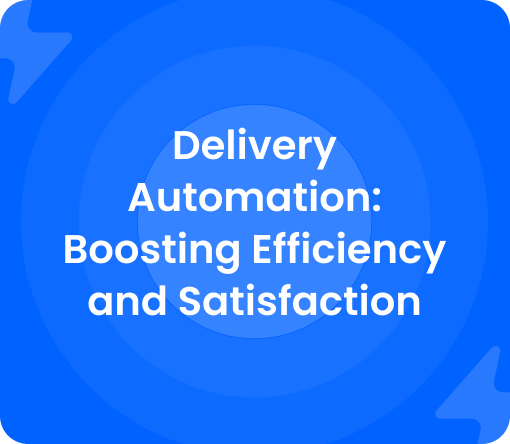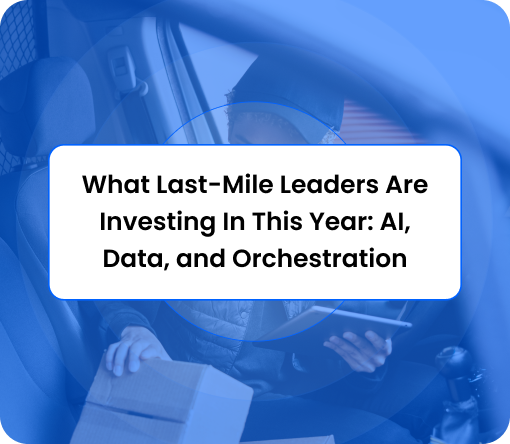The last mile isn’t just the final leg of delivery—it’s often the most complex and expensive. As customer expectations rise and logistics operations scale, many businesses are asking a critical question: Is it time to move from traditional delivery tech to AI-powered tools?
From smarter routing to predictive delivery windows, AI is rapidly changing how companies manage the final stretch. But it’s not always clear when—or if—it’s worth the switch. Let’s break down what AI can offer, where traditional tools still shine, and how to evaluate what’s best for your business.
The Rise of AI in Last-Mile Delivery
AI is no longer reserved for future-forward logistics giants, it’s quickly becoming a foundational tool for businesses of all sizes trying to improve delivery speed, reduce costs, and stay competitive. As delivery expectations climb, AI offers a path to smarter, more adaptive operations that traditional tech simply can’t match.
From auto-rerouting drivers mid-delivery to powering live tracking and proactive updates, AI gives teams the agility to meet demand in real-time, without breaking operations.
Here are four key ways AI is reshaping last-mile delivery:
1. Smarter, Real-Time Route Optimization
Unlike traditional route planning, which is often static and based on preset rules, AI-powered systems continuously learn from data. These tools analyze factors like:
- Historical traffic patterns
- Real-time congestion
- Road closures or construction
- Weather conditions
- Customer-specific delivery windows
- Driver performance history
Instead of calculating “fastest” routes once at dispatch, AI systems dynamically adjust in real time, even rerouting drivers mid-route if conditions change. The result? Fewer delays, lower fuel costs, and better ETAs for customers.
2. Predictive Delivery Windows and SLAs
AI doesn’t just help in the moment—it can forecast what’s likely to happen before a single package leaves the building. By learning from past deliveries, customer behavior, and geography, AI can:
- Predict delivery windows with greater accuracy
- Identify high-risk orders likely to miss SLAs
- Recommend adjustments in staffing or capacity
This helps operations teams get ahead of issues rather than react to them—and it builds trust with customers expecting on-time arrivals.
3. Address Intelligence and Delivery Validation
Incorrect or incomplete addresses remain a huge (and expensive) challenge in last-mile logistics. AI-driven validation tools scan address fields and cross-reference postal data, customer behavior, and delivery history to:
- Fix typos or formatting issues
- Suggest missing unit numbers
- Identify non-deliverable addresses before dispatch
- Alert teams when a location has frequent failed attempts
By proactively cleaning and validating addresses, businesses reduce the number of failed deliveries, costly re-attempts, and customer support tickets.
Bonus Benefit: Better address quality also improves driver efficiency—no more circling neighborhoods or rerouting mid-route due to bad data.
4. Automated Support and Customer Updates
AI-powered chatbots and communication tools have come a long way. Today, they’re capable of handling:
- Real-time order updates
- Delivery reschedules
- FAQs about timing, product status, or tracking
- Triage for issues like “package not received” or “left in wrong location”
And because these systems integrate with your delivery platform, they can respond instantly with accurate, up-to-the-minute information.
Why This Matters Now
The rise of AI in last-mile delivery isn’t just about innovation for innovation’s sake, it’s a response to very real pressure:
- More deliveries are happening than ever before
- Customers expect faster, more transparent service
- Delivery costs are rising, and inefficiency adds up quickly
AI gives businesses a way to adapt in real-time, stay resilient in unpredictable conditions, and consistently deliver better customer experiences, all while scaling smarter.
That said, AI isn’t a magic wand. It’s a tool, one that works best when paired with good data, a clear strategy, and the right operational foundation.
Traditional Tech Still Has a Place
AI may be the headline grabber, but traditional logistics tools still make up the foundation of many last-mile delivery operations. From route scheduling software to basic dispatch systems and manual tracking spreadsheets, these solutions have powered delivery networks for years, and in many cases, continue to do so.
Where Traditional Tech Works Well
For businesses with simple delivery operations, traditional systems often cover the basics:
- Predictable routes: Rule-based routing works well for businesses with fixed delivery zones or scheduled stops.
- Low order volume: Smaller teams or single-location retailers can often manage deliveries without the need for advanced automation.
- Limited variability: When the number of SKUs, customer preferences, and service levels are relatively stable, simpler systems offer a manageable solution.
Many businesses start here, especially those building out a delivery offering for the first time.
Known Limitations
However, as operations grow or become more complex, traditional systems can start to show their limits:
- Scalability: Manual processes and static systems often struggle under increased volume or geographic expansion.
- Responsiveness: Rule-based tools lack the ability to adapt in real time to factors like weather, traffic, or rerouted orders.
- Customer experience: Today’s consumers expect more than just a delivery—they want transparency, live tracking, and proactive updates. Traditional tools weren’t built for that level of engagement.
Bottom Line
There’s no one-size-fits-all tech stack for last-mile delivery. Traditional tools still work well in specific use cases—especially for businesses with predictable, local delivery needs. But for companies facing growing customer expectations, complex workflows, or geographic scale, traditional systems may require augmentation to stay competitive.
The key is understanding where your business sits today—and where it’s headed.
AI vs. Traditional: A Side-by-Side Comparison
.svg)
What’s the ROI of AI?
When considering AI for last-mile delivery, the key question isn’t just “Is it cutting-edge?” but rather, “Will it pay off?” The return on investment depends on your scale, existing infrastructure, and how effectively AI is implemented.
Here are a few core areas where AI can drive measurable impact:
- Lower Delivery Costs: AI-powered route optimization can reduce miles driven, fuel usage, and driver hours by dynamically adjusting to traffic patterns, order clustering, and real-time disruptions.
Impact: Some logistics companies report a 10–30% reduction in delivery costs through smarter route planning. - Faster Delivery Times: AI doesn’t just optimize for efficiency—it also improves speed. Machine learning models can reassign delayed orders, predict optimal dispatch times, and help carriers avoid bottlenecks.
Impact: Brands leveraging AI-based dispatch tools have cut average delivery windows by up to 20%. - Higher First-Attempt Delivery Rates: By using predictive data (like customer availability patterns or past delivery behaviors), AI systems help ensure the delivery succeeds the first time—reducing redelivery costs and delays.
Impact: Businesses have seen up to a 15% boost in first-attempt success rates, especially in urban areas. - Better Forecasting for Demand and Resources: AI tools help teams predict peak periods, align staffing, and stock delivery-ready inventory more efficiently—cutting down on last-minute scrambling and overtime.
Impact: This can reduce staffing inefficiencies and stockouts, and improve delivery SLAs. - Improved Customer Experience (and Retention): With live tracking, real-time ETA adjustments, and automated updates powered by AI, customer satisfaction scores often increase—along with repeat purchases.
Impact: Higher CSAT and Net Promoter Scores (NPS), especially for brands offering on-demand or time-sensitive products. - Time Savings for Ops Teams: By automating manual tasks like dispatching, rerouting, or exception handling, AI frees up operations teams to focus on higher-value work.
Impact: Many teams report a 30–50% reduction in time spent managing day-to-day delivery logistics.
So, is the ROI guaranteed?
Not quite. Like any tech investment, success depends on execution. AI needs clean data, thoughtful implementation, and alignment with business goals to be effective. That’s why many businesses start with one use case, like routing or tracking, before expanding.
But when used strategically, AI can become a long-term competitive advantage, reducing costs, improving service levels, and helping teams do more with less.
How to Implement AI Tools Without Getting Burned
AI is powerful—but only when it’s implemented thoughtfully. Too often, companies chase “AI transformation” without a clear plan, leading to bloated costs, broken workflows, and frustrated teams. Whether you're testing your first AI-driven solution or scaling an existing one, these practical steps can help you adopt responsibly and avoid the common pitfalls.
- Start With a Real Problem, Not Just a Trend: Before evaluating any tools, define the specific issue you want to solve. Are you struggling with high failed delivery rates? Manual dispatching? Delayed customer updates?
- Evaluate Your Current Tech and Data Readiness: AI relies heavily on data. If your delivery data is scattered, incomplete, or unstructured, even the best AI tool will struggle to deliver accurate insights.
What to do: Assess your current systems for things like route performance data, driver history, customer delivery preferences, or fulfillment timelines. Clean, centralized data makes for smoother implementation and better results. - Choose Solutions That Integrate With Your Existing Stack: The best AI tools are the ones that play nicely with your current systems—POS, order management, CRM, or logistics platforms. Avoid tools that require ripping and replacing your infrastructure unless you’re prepared for a long-term overhaul.
Pro tip: Look for API-first platforms or modular AI features you can add on without disrupting your operations. - Don’t Automate Everything at Once: AI should augment your team, not replace all logic overnight. Automating complex workflows before understanding them can lead to more errors, not fewer.
How to avoid this: Start with AI suggestions rather than full automation (e.g., suggested delivery windows, recommended drivers) before switching to automatic execution. Think of AI as a copilot, not an autopilot. - Involve Your Team Early: It’s easy to treat AI as a plug-and-play solution, but successful implementation depends on people as much as technology.
- Monitor, Measure, and Adjust Continuously: AI isn’t static. Models evolve, and so should your expectations. Track performance from the beginning—delivery time improvements, reduction in manual tasks, customer feedback, etc.
AI is a powerful tool, not a magic bullet. If implemented thoughtfully, it can dramatically improve the way you manage deliveries. But poor planning or unrealistic expectations can create more work than it solves.
Start small. Stay focused. Bring your team along for the journey. That’s how you future-proof your last-mile strategy—with confidence, not chaos.
Final Thoughts
AI isn’t here to replace traditional logistics tools, it’s here to complement them. For high-growth companies, it can unlock major efficiency gains and elevate the customer experience. But for others, especially those with tight resources or simpler delivery models, the tried-and-true methods might still be the best fit.
The question isn’t “AI or not?”—it’s “Where will AI deliver the most impact for your business?


















%20(5).png)







.png)
%20(36).png)





